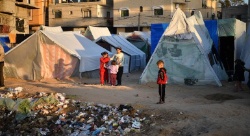Asia’s Declining Fertility Patterns Under Spotligh
Asia’s Declining Fertility Patterns Under Spotlight at UN Conference
New York, Dec 19 2006 2:00PM
Demographers and population specialists from 14 Asian nations have gathered in Bangkok for a three-day conference organized by the United Nations to discuss the latest challenges and issues posed by the region’s declining fertility rates.
The seminar, set up by the UN Economic and Social Commission for Asia and the Pacific (UNESCAP), is examining why there are such differences in both the rates of fertility and the scale of the decline in those rates between countries within the region.
The average number of children per Asian woman is currently 2.3, but national rates vary from more than five in Afghanistan and Timor-Leste to less than 1.5 in the Republic of Korea, Japan, Singapore and Hong Kong, China.
In her statement at the conference’s opening yesterday, Thelma Kay, Director of UNESCAP’s Emerging Social Issues Division, said that in some Asian countries socio-economic development has been the crucial factor contributing to a decline in fertility, while in others family planning programmes made the difference.
“However, it has been highlighted that sustained fertility decline has occurred in countries where both these factors have been in operation,” she said.
“Among the socio-economic factors, urbanization, delay in age at marriage, especially among women, better education of women and higher labour force participation of women have been the driving forces behind fertility decline.”
Marital status is also critical, according to the population experts, with little child-bearing outside of marriage in Asia, particularly in comparison to Northern and Western Europe.
The conference aims to help governments develop guidelines for future policy research, suggest policy recommendations and develop specific programmes to boost the quality of life of people in the region.
ENDS


 UN News: 10,000 People Feared Buried Under The Rubble In Gaza
UN News: 10,000 People Feared Buried Under The Rubble In Gaza Save The Children: Heat-stricken Bangladesh Extends School Closures
Save The Children: Heat-stricken Bangladesh Extends School Closures Hayden Stephens and Associates: Record Class Action Settlement Gives Hope To 50,000 Australian Junior Doctors
Hayden Stephens and Associates: Record Class Action Settlement Gives Hope To 50,000 Australian Junior Doctors UN News: Healing Page By Page In Earthquake-affected Türkiye
UN News: Healing Page By Page In Earthquake-affected Türkiye Save The Children: Rate Of Attacks On Healthcare in Gaza Higher Than In Any Other Conflict Since 2018
Save The Children: Rate Of Attacks On Healthcare in Gaza Higher Than In Any Other Conflict Since 2018 UN News: Green Light For New Cholera Vaccine, Ukraine Attacks Condemned, Action Against Racism
UN News: Green Light For New Cholera Vaccine, Ukraine Attacks Condemned, Action Against Racism